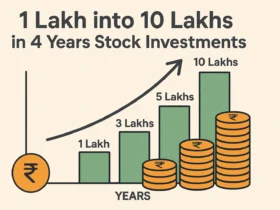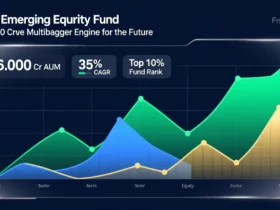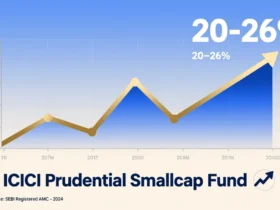Did you know Bajaj Finance Fixed Deposits (FDs) offer up to 8.85% p.a. for seniors and 8.60% p.a. for others1? This shows how complex financial planning has become. Investors now face a choice between guaranteed returns and the chance for higher gains. Mutual funds can yield 7% to 9%1, while FDs offer fixed returns from 3% to 10%1.
Choosing between these options requires looking at risk, liquidity, and your financial goals. It’s not just about the money.
FDs keep your money safe with no risk2. On the other hand, mutual funds offer diversification and expert management2. Both are big in India, but they differ in returns, taxes, and flexibility. For example, FDs need a minimum of Rs. 15,0001. Mutual funds, though, can start with less but might have fees2.
As rates and trends change, this guide helps you understand both options. Whether you want steady returns or growth, knowing these details can help shape your financial plans.
Key Takeaways
- FDs promise returns up to 8.85% p.a., while mutual funds offer 7%-9% with market swings12.
- FDs offer moderate liquidity, but you can withdraw early. Mutual funds let you exit quickly12.
- Risk levels differ: FDs are “no risk” and RBI-regulated, while mutual funds rely on market performance12.
- Tax rules vary, with FDs taxed at source over Rs. 5,000 interest and mutual funds taxed on gains12.
- FDs are good for short-term goals, while mutual funds are for long-term growth in financial planning2.
Understanding the Basics: What Are Mutual Funds and Fixed Deposits?
Investment basics include understanding mutual funds and fixed deposits. These are two investment types with different risks, returns, and management styles. Let’s dive into how they work and compare them.
Mutual funds combine money from investors into a single pool. This pool is then invested in various assets like stocks and bonds. Professional managers choose where to put the money, aiming for growth. The average growth rate of mutual funds is 17%3.
The returns from mutual funds depend on the market. They also have expense ratios, which range from 0.1% to 2.5%4. These fees are taken from the returns.
Fixed deposits are offered by banks and non-banking financial companies (NBFCs). You put in a sum of money for a set period and earn a fixed interest rate. Today, bank FDs offer interest rates between 4% and 6%, down from 12% in 19954.
Interest from fixed deposits is subject to TDS, which can reduce your after-tax earnings4.
| Parameter | Mutual Funds | Fixed Deposits |
|---|---|---|
| Returns | Market-linked (variable) | Fixed rate |
| Risk | Higher (market fluctuations)3 | Lower market risk, but default risk4 |
| Management | Active (professional managers)3 | Passive (no active management) |
| Liquidity | High (can redeem anytime) | Medium (penalties for early withdrawal) |
| Regulation | SEBI-regulated | RBI-regulated |
Make an informed choice based on your financial goals and risk comfort. Learn more about these investment types as you plan your investment strategy.
Returns Comparison: Historical Performance Analysis
Investment returns for mutual funds and fixed deposits change over time. Mutual funds usually do better than FDs in the long run. Here’s a look at returns over key periods using real data56:
Over 5 years, equity mutual funds gave 3-4x more returns than FDs. For example, ₹10,000 in a large-cap fund grew 4.3x by 2006. FDs only grew 33%6. This shows equity’s strong growth, even with short-term ups and downs.
In bear markets (2006–2011), FDs did better6. But mutual funds bounced back strongly after.
- Average equity fund returns: 10-15% annually5
- FD interest rates: 6-8% annually5
- FDs are tax-advantaged for short terms, but mutual funds compound better long-term5
When comparing returns, we must consider inflation. Equity mutual funds beat inflation better than FDs. A ₹5,000/month SIP at 12% returns becomes over ₹10 lakh in 10 years5. While FDs protect your principal, their post-tax returns often fall short over a decade.
Mutual Fund Vs Fixed Deposit – What Is Best for You?
When deciding between mutual funds and fixed deposits, think about your investment goals and financial objectives. Your investment strategy should show if you want safety or growth. Let’s see how each option fits different needs.
Short-term Financial Goals (1–3 years): Fixed deposits are great for steady returns with little risk7. But, liquid mutual funds might offer similar after-tax returns. Debt funds average 6–9% yearly, a bit more than FDs’ 7% before tax89.
Long-term Wealth Creation (7+ years): Mutual funds are top for long-term growth. Equity funds beat FDs over time, beating inflation8. Also, mutual fund gains are taxed at 10%, while FD interest faces higher taxes9.
Emergency Funds: FDs are safe but have penalties for early withdrawal8. Liquid funds offer quick access without lock-ins, balancing safety and liquidity9. Aim to keep 3–6 months’ expenses in these funds for emergencies.
Investment Experience: New investors often start with FDs for ease. As they learn, they move to mutual funds for market-linked gains7. Mixing both can balance safety and growth.
The choice depends on your risk comfort and time frame. Many mix both for a balanced portfolio that meets their investment goals.
Risk Assessment: Volatility vs Guaranteed Returns
Choosing between mutual funds and fixed deposits requires careful risk assessment. Fixed deposits promise returns but can lose value to inflation. Mutual funds offer the chance for growth but come with market investment risk. Let’s look at these factors.

Market Risks in Mutual Funds
Equity mutual funds can be unpredictable due to market changes. Top performers have seen returns of 11-13% over 10 years10. But, they can also see losses in the short term. Debt funds are sensitive to interest rates, which can lower their value. With expense ratios of 1-2%11, costs can rise during downturns. This shows why equity funds need patience.
Interest Rate Risks in Fixed Deposits
- FD returns stay fixed even if market rates rise, locking investors in lower yields10
- Reinvestment risk occurs when FD maturity rates are lower than original terms
- Bank failures (covered up to ₹5 lakh) remain a remote but possible risk10
Inflation Impact on Both Investment Types
FD returns often trail inflation after taxes. Mutual funds, despite short-term ups and downs, have given positive real returns over 5+ years11. Equity funds have beaten inflation in 80% of 10-year periods starting 200011. Debt funds have offered stable returns that match inflation.
It’s important to understand these risks and how they match your financial goals. Always prioritize risk assessment based on your time horizon and risk tolerance.
Liquidity and Flexibility Factors
When picking between mutual funds and fixed deposits, liquidity is key. Fixed deposits let you withdraw early but you’ll lose 1% of your interest12. This means you get your money back but with less interest. On the other hand, mutual funds like liquid funds can be cashed in quickly, usually in 1–2 business days13
Financial flexibility is also different. Fixed deposits don’t have a lock-in period for most, but some do. Mutual funds, except for ELSS, let you take your money out anytime12. Liquid funds don’t have exit loads, making them great for short-term goals. Some even let you take up to ₹50,000 out instantly.
- FDs penalize early withdrawal but guarantee capital safety12.
- Liquid funds provide daily NAVs and instant access to cash reserves13.
- ELSS lock-in periods ensure long-term growth but restrict short-term use12.
When it comes to paying back, mutual funds offer SWPs for regular income. FDs can be used as collateral for loans, giving you better terms14. If you need quick access to your money, FDs might be better. But if you want more flexibility and tax benefits, mutual funds are the way to go.
Knowing these points helps match your investment with your financial needs. Whether it’s the fixed terms of FDs or the flexible nature of mutual funds, finding the right balance is key to good investing14.
Tax Implications for Indian Investors
Knowing about investment taxation helps you earn more. Mutual funds and fixed deposits are taxed differently. This affects how much you keep after taxes. Let’s look at the rules.
Taxation of Mutual Fund Returns
Equity and debt mutual funds have different tax rules15. Equity funds gain over a year are taxed at 12.5% if over ₹1.5 lakh15. Short-term gains are taxed at 15%16. Debt funds gain over 36 months are taxed at 20% with indexation15. Dividends over ₹5,000 are taxed at your income rate15.
Tax Structure for Fixed Deposit Interest
FD interest is taxed based on your income. TDS of 10% is applied if interest is over ₹10,000 a year16. Tax-saving FDs can reduce taxable income by up to ₹1.5 lakh under Section 80C16.
Tax-Saving Options in Both Categories
ELSS mutual funds have 3-year lock-ins and 80C deductions. Tax-saving FDs need 5 years16. Here’s a table comparing their after-tax returns:
| Feature | Mutual Funds | Fixed Deposits |
|---|---|---|
| Long-term tax rate | 12.5% (equity) or 20% (debt) | Slab rate |
| Indexation benefit | Available for debt funds | No |
| TDS threshold | ₹5,000 | ₹10,000 |
ELSS can save ₹30,000 a year for those in the 20% tax bracket16. Pick based on your tax rate and how long you can invest to get the most tax benefits.
Latest Market Trends and Regulatory Changes in India
Market trends and regulatory changes are affecting mutual funds and fixed deposits. The RBI and SEBI have made updates that change how we look at risk and return17.
- RBI raised the repo rate to 6.5% in 2024, affecting FD interest and debt fund yields18.
- SEBI’s new expense ratio caps keep mutual fund fees low. Index funds like Axis Nifty 50 (32.80% 1-yr return) are leading18.
- FD insurance coverage now covers up to ₹5 lakh per depositor under DICGC, making it safer17.
Demand for digital FD products is growing. They offer flexible tenures (7 days to 10 years) and instant redemption for mutual funds17. Tax reforms, like revised TDS thresholds on FD interest, need close monitoring of investment regulations19.

Index funds with low expense ratios (e.g., Axis Nifty 100 at 0.21%) are gaining popularity. They offer guaranteed returns like traditional FDs18. Banks now offer hybrid FDs with tax-saving features under Section 80C17.
We suggest investors keep up with tax rules and liquidity options. Regulatory changes are constantly reshaping the investment world19.
Conclusion: Creating Your Balanced Investment Strategy
A good portfolio strategy mixes stability and growth. Fixed Deposits (FDs) are popular, holding 53% of household savings in India10. They offer guaranteed returns with little risk. On the other hand, mutual funds grow at 17% CAGR over two decades10. They offer higher returns but need a risk-taking mindset.
To find investment balance, use FDs for short-term needs like emergencies. Their fixed rates and tax benefits under Section 80C20 make them ideal. For long-term goals like retirement, mutual funds are better. They can beat inflation, with equity funds yielding 11-13% annually over a decade11.
Asset allocation depends on how much risk you can take. Conservative investors might put 70% in FDs and 30% in debt funds. Aggressive investors could do the opposite. Remember, tax matters: FD interest is taxed at slab rates20, while equity mutual funds over ₹1 lakh incur 10% LTCG tax after one year11. Debt funds taxed at 20% with indexation after 36 months11 offer better post-tax returns.
Begin with a SIP of ₹500 in mutual funds20 to diversify. Keep FDs for quick access to cash. Review your portfolio strategy every year, adjusting as your life changes. Whether you focus on safety or growth, mixing both ensures a strong asset allocation that meets your financial goals.
FAQ
What is the main difference between mutual funds and fixed deposits?
Mutual funds pool money to invest in many assets, with returns that can vary. Fixed deposits, on the other hand, offer a fixed interest rate for a set time. They are safer and more predictable.
How do mutual funds calculate their returns?
Mutual funds use the Net Asset Value (NAV) to figure out their returns. The NAV is the total value of the fund’s assets minus its liabilities, divided by the number of shares. This value changes with the market.
Are fixed deposits completely risk-free?
Fixed deposits are low-risk but not completely risk-free. They face risks like interest rate changes, reinvestment risks, and inflation risks. These can affect the returns.
How do taxes on mutual funds differ from those on fixed deposits?
Mutual fund gains are taxed based on the fund type and how long you hold them. Fixed deposit interest, on the other hand, is taxed based on your income tax rate, no matter the duration.
What are the liquidity differences between mutual funds and fixed deposits?
Mutual funds usually offer better liquidity, with quick redemption options. Fixed deposits, while less flexible, may have penalties for early withdrawal.
Can I use mutual funds or fixed deposits as collateral for loans?
Yes, you can use fixed deposits as collateral for loans. They often offer better loan-to-value ratios. Some mutual funds also provide overdraft facilities, giving more options for using your investments.
How can inflation affect my investments in mutual funds and fixed deposits?
Inflation can reduce the real returns on fixed deposits, as their rates may not keep up with inflation. Mutual funds, like equity funds, can offer better returns over time, beating inflation.
What is the best choice for short-term financial goals?
For short-term goals (1-3 years), consider liquid or ultra-short-term debt funds. They offer better liquidity and flexibility than fixed deposits, though with slightly more volatility.
How should I approach my investment strategy?
We suggest a goal-based investment strategy. Your financial goals should guide your choice of investments. A balanced portfolio might include mutual funds for growth and fixed deposits for stability and emergencies.






























1 Comment